Treble is the high-frequency component in music that defines brightness, clarity, and detail in sound.
It can make a mix sparkle and shine, or (when overdone) create a harsh sound that the human ear perceives super uncomfortable to listen to.
Treble frequencies have the ability to bring out the shimmer in cymbals, the sibilance in vocals, and the crispness in guitar strings.
As producers, knowing the answer to “what is treble?” can completely transform how a track feels and how well it translates across different audio systems.
That’s why we’re breaking down everything you need to know, like:
- What is treble exactly? (and we’re not talking a treble clef) ✓
- Treble range in the frequency spectrum ✓
- How treble affects sound quality/perception ✓
- The role of treble in vocals, string instruments, and percussion ✓
- Treble and bass frequencies (bass versus treble) ✓
- How to control treble in music production ✓
- Common tools and plugins for controlling treble frequencies ✓
- Advanced tips for treble control ✓
- Specific examples and techniques for managing treble like a pro ✓
- Much more to help you answer what is treble ✓
By the end of this article, you’ll know everything about what is treble and how it fits into the overall audio frequency spectrum.
It’ll help you knock out mixes with enhanced sound quality and achieve the perfect balance between treble and bass frequencies.
Plus prevent your tracks from sounding muddy or overly bright, because nobody has time for that.
You’ll be able to boost, cut, and shape treble frequencies like a professional so your music always sounds crisp, clear, and captivating across all sound systems.
So, let’s dive in…
Table of Contents
What is Treble Exactly?
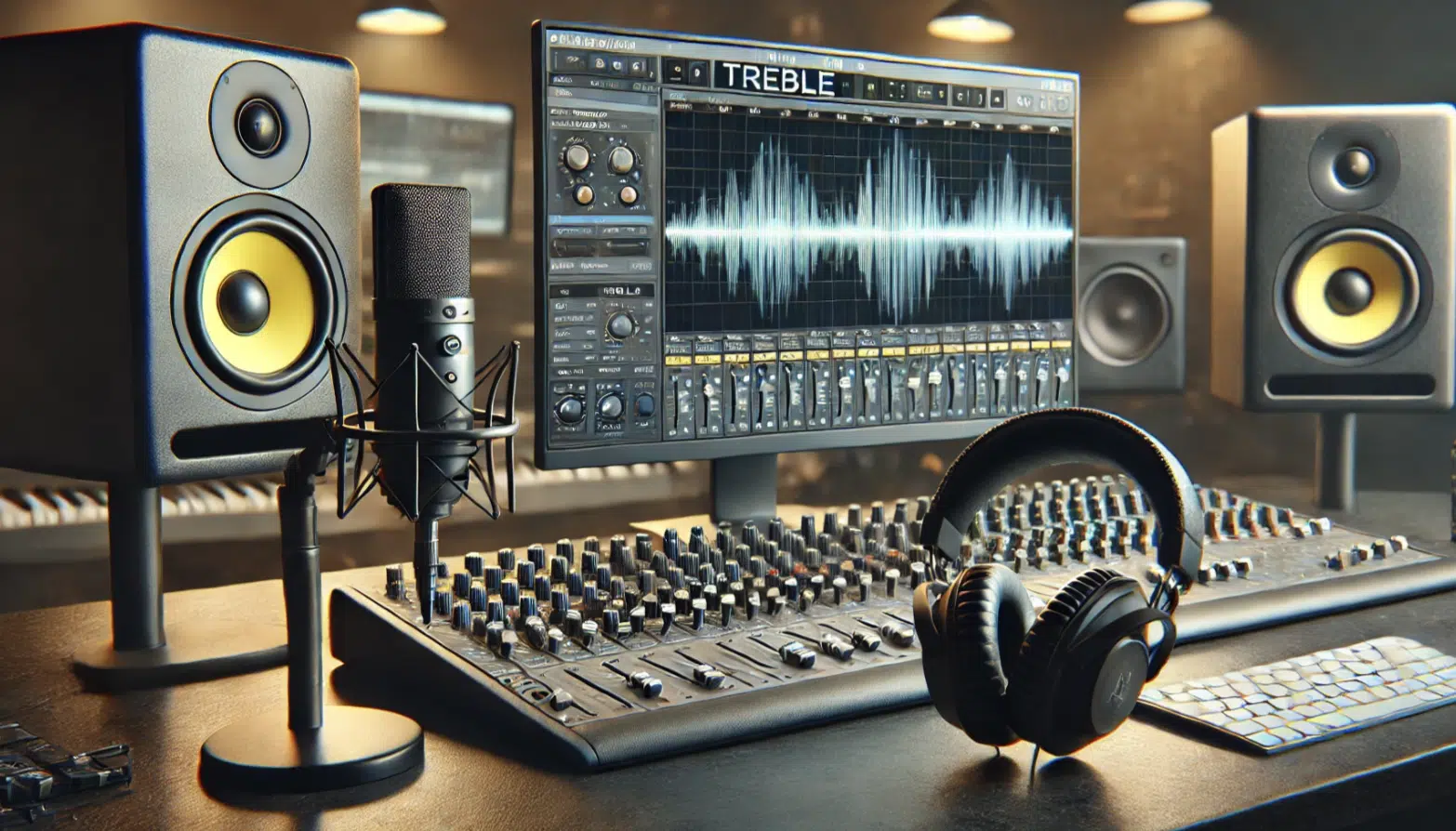
Treble refers to the higher frequencies in the audio spectrum that range from around 6,000 Hz to 20,000 Hz.
These frequencies are responsible for the clarity, brightness, and presence of a sound.
When talking about treble, think of the:
- Sharp cymbals
- Sibilance in vocals
- Shimmer of a snare drum’s high frequencies
Treble plays a huge role in defining the crispness of a mix 一 contributing to a balanced and polished final product.
It’s these treble frequencies that help the human ear perceive detail, separation, and articulation in the music, which we’ll break down throughout the article.
Treble Range in the Frequency Spectrum
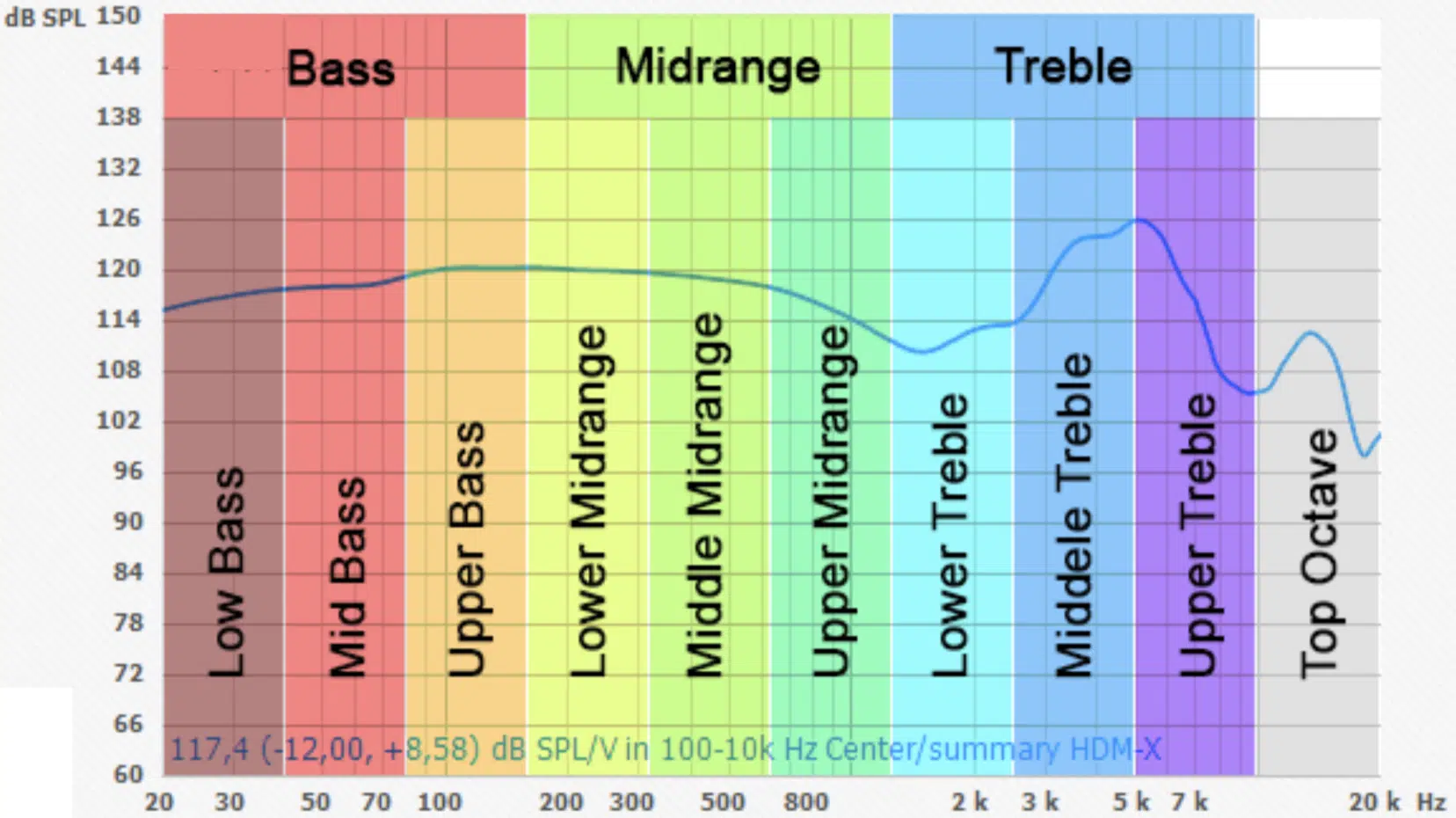
The treble range is part of the higher end of the audio frequency spectrum, extending from 6,000 Hz up to 20,000 Hz.
The human ear can hear higher frequencies within this range, but it starts to decline as we age, especially the upper treble (above 15,000 Hz).
Within this frequency range, you’ll also find subdivisions such as:
- The lower treble 一 Frequencies ranging from 6,000 Hz to 8,000 Hz.
- Mid treble 一 Frequencies ranging from 8,000 Hz to 12,000 Hz.
- Upper treble 一 Frequencies ranging from 12,000 Hz to 20,000 Hz.
Each of these sub-ranges has a unique effect on how a sound is perceived, so it’s important for you to know them.
For example, the mid treble enhances the attack of snare drums and the sharpness of a singer’s voice, while the upper treble brings out the air and brightness of a mix.
A well-balanced treble frequency range can prevent a mix from sounding too muddy or dull, which is something you never want.
It’s also important to know that excessive treble can lead to a harsh sound, which is fatiguing to listen to 一 making the balance of treble crucial for sound quality.
Side note, if you want to find out all the mixing mistakes that you need to look out for, we’ve got you covered.
-
How Treble Affects Sound Quality/Perception
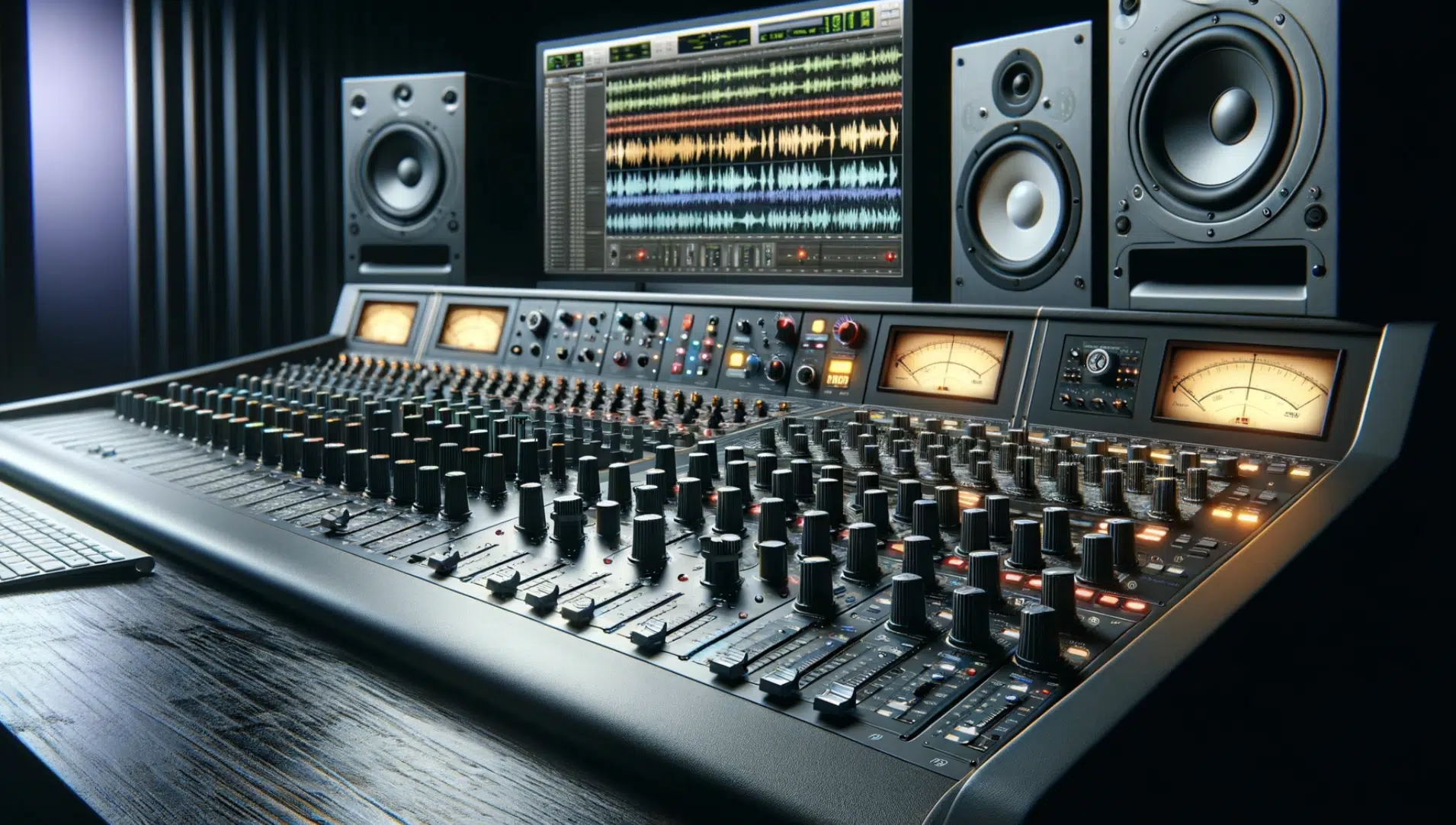
Treble frequencies play a significant role in shaping the sound quality by enhancing the brightness, clarity, and definition of a mix.
Higher frequencies in the treble frequency range, especially from 10,000 Hz to 20,000 Hz, contribute to a bright sound.
It allows the human ear to perceive details such as the shimmer of cymbals, the snap of snare drums, and the upper harmonics of a singer’s voice.
However, if treble frequencies (particularly the upper treble) are too pronounced, they can create a harsh sound that is fatiguing for the human ear.
This is especially true when it comes to small audio systems like tiny speakers or wireless headphones.
Balancing the treble frequency range properly ensures that the audio system delivers a clean and clear sound without overshadowing the mid-range frequencies or making the bass sound too weak.
Treble and Bass Frequencies: Understanding the Balance
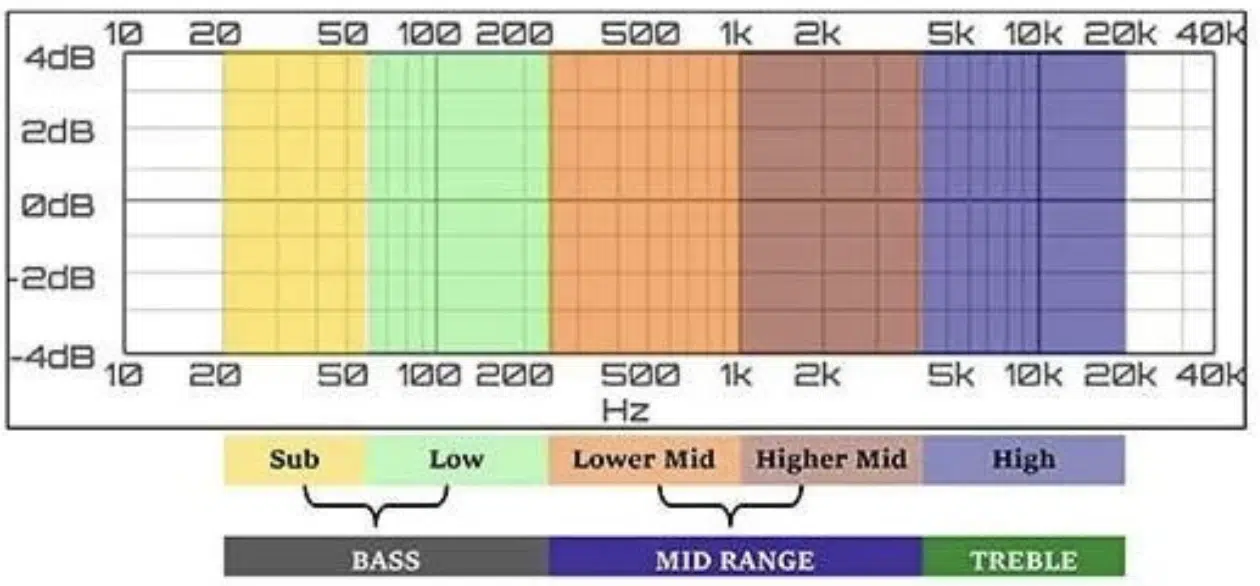
Understanding the balance between treble and bass frequencies is super important for achieving optimal sound quality in music production.
Treble and bass occupy different parts of the audio frequency spectrum:
- Treble frequencies range from around 6,000 Hz to 20,000 Hz.
- Bass frequencies typically fall between 20 Hz and 250 Hz.
Finding the right balance between these ranges is really what it’s all about…
Too much treble frequency range can create a harsh sound, while excessive bass frequencies can make the bass sound louder but muddy.
It’ll drown out mid-range frequencies, which you certainly don’t want.
You’re going to want to adjust the treble and bass frequencies using EQ to ensure that both the high-end and low-end are balanced for clarity and fullness.
For example, boosting the lower treble range between 6,000 Hz and 8,000 Hz can add brightness to rhythm guitars.
While, on the flip side, a slight cut in the mid treble/mid frequencies around 8,000 Hz to 10,000 Hz can prevent a harsh sound when working with vocals or treble strings.
On the other hand, cutting sub-bass around 20 Hz to 40 Hz can tighten up the bass guitar or kick drum without making the bass frequencies too overpowering.
If you want a balanced mix, you’ll need to manage how treble sounds blend with bass sounds 一 ensuring neither overshadows the other.
This delicate balancing act between treble and bass versus mid-range frequencies is what shapes the overall audio quality and listening experience.
How to Control Treble in Music Production
Controlling treble frequencies is essential for achieving a well-balanced and high-quality mix as we talked about. In music production, you’re going to use various techniques and tools to shape the treble range, enhancing or reducing treble frequencies to achieve the desired sound. Let’s break them down now…
-
Using Equalizers (EQ) to Shape Treble
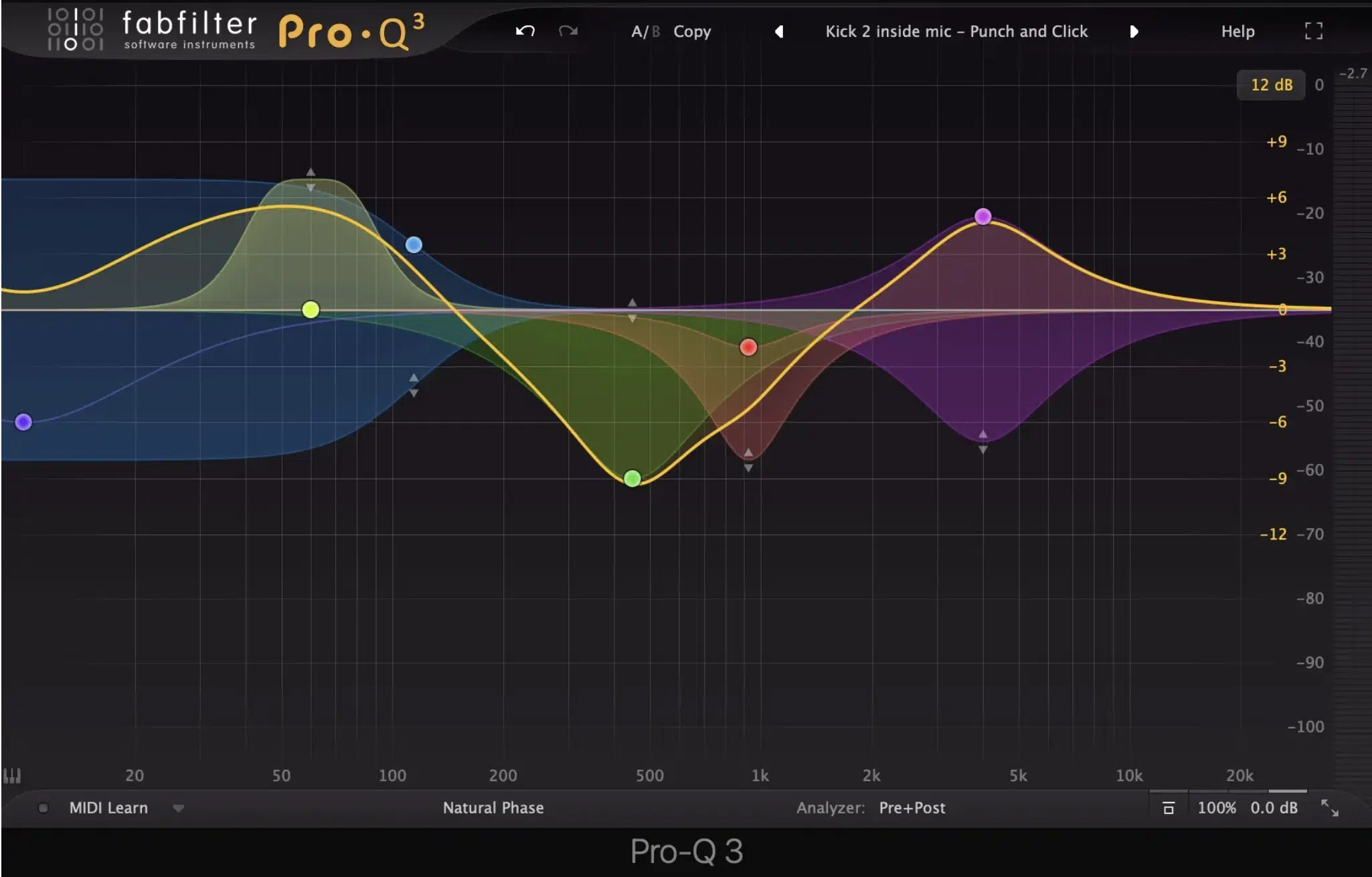
Equalizers (EQ) are great for shaping treble frequencies across various frequency ranges, and one of my personal favorites.
A parametric EQ allows precise control over the treble range by boosting or cutting specific frequencies.
For instance, boosting the treble frequency range between 8,000 Hz and 12,000 Hz can add brightness and presence to vocals and rhythm guitars.
Cutting the lower treble around 6,000 Hz to 8,000 Hz can reduce a harsh sound in a singer’s voice or snare drums.
Using EQ helps balance treble and bass frequencies, preventing the bass sound from being overwhelmed by high frequencies and maintaining clarity across the audio spectrum.
-
Treble Boosting Techniques
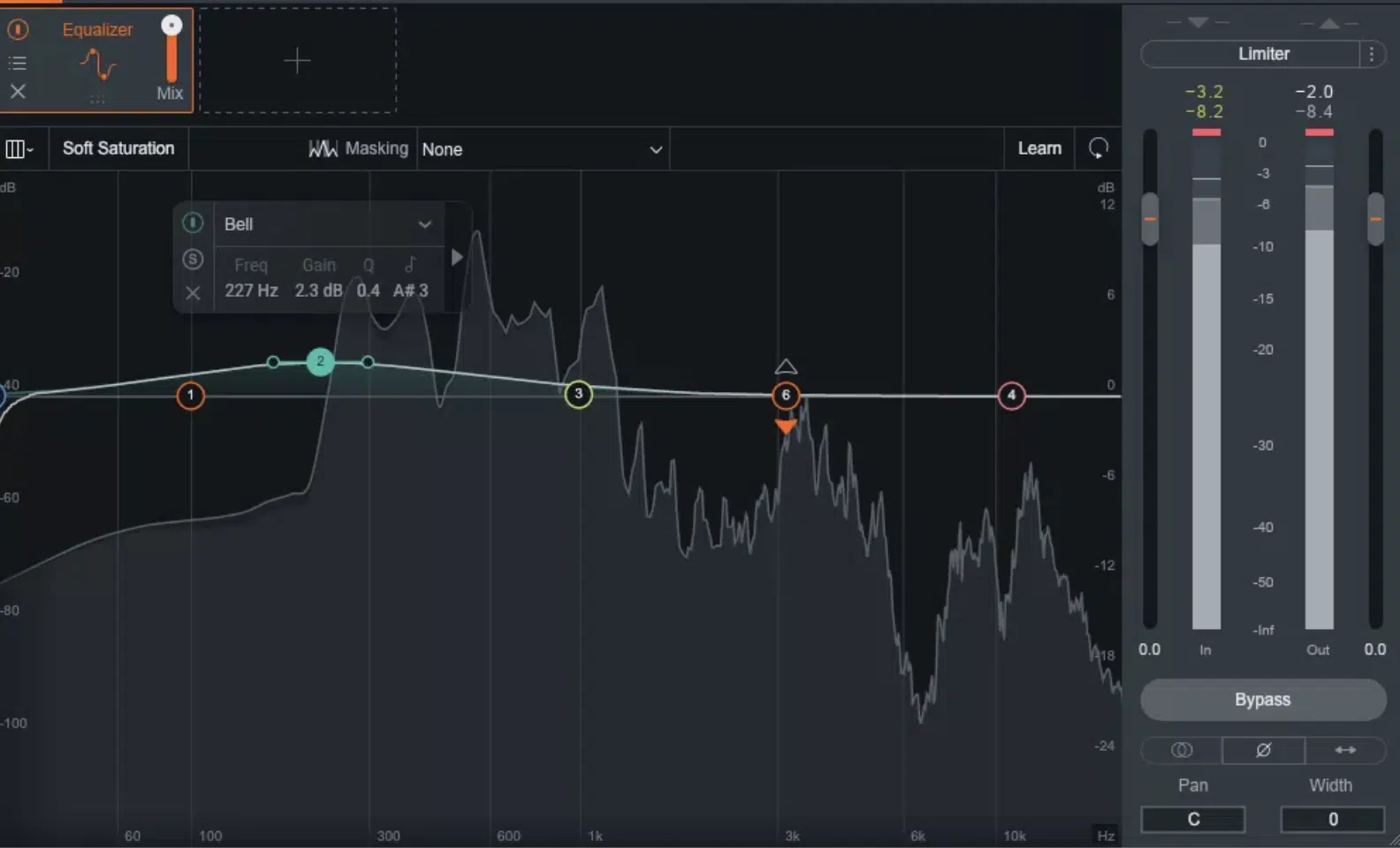
Treble boosting techniques are crucial when aiming to add more clarity and brightness to a mix, especially in music genres like pop and classical music where treble frequencies are vital.
One common technique is to use a high-shelf filter in an EQ to gently boost the upper treble frequencies above 10,000 Hz 一 adding air and definition to the mix.
However, it’s important to monitor these boosts carefully, as too much upper treble can lead to a harsh sound that is unpleasant on tiny speakers called tweeters or wireless headphones.
A balanced approach can bring out the details in high-pitched sounds without making the overall sound too shrill.
-
Treble Cutting Techniques
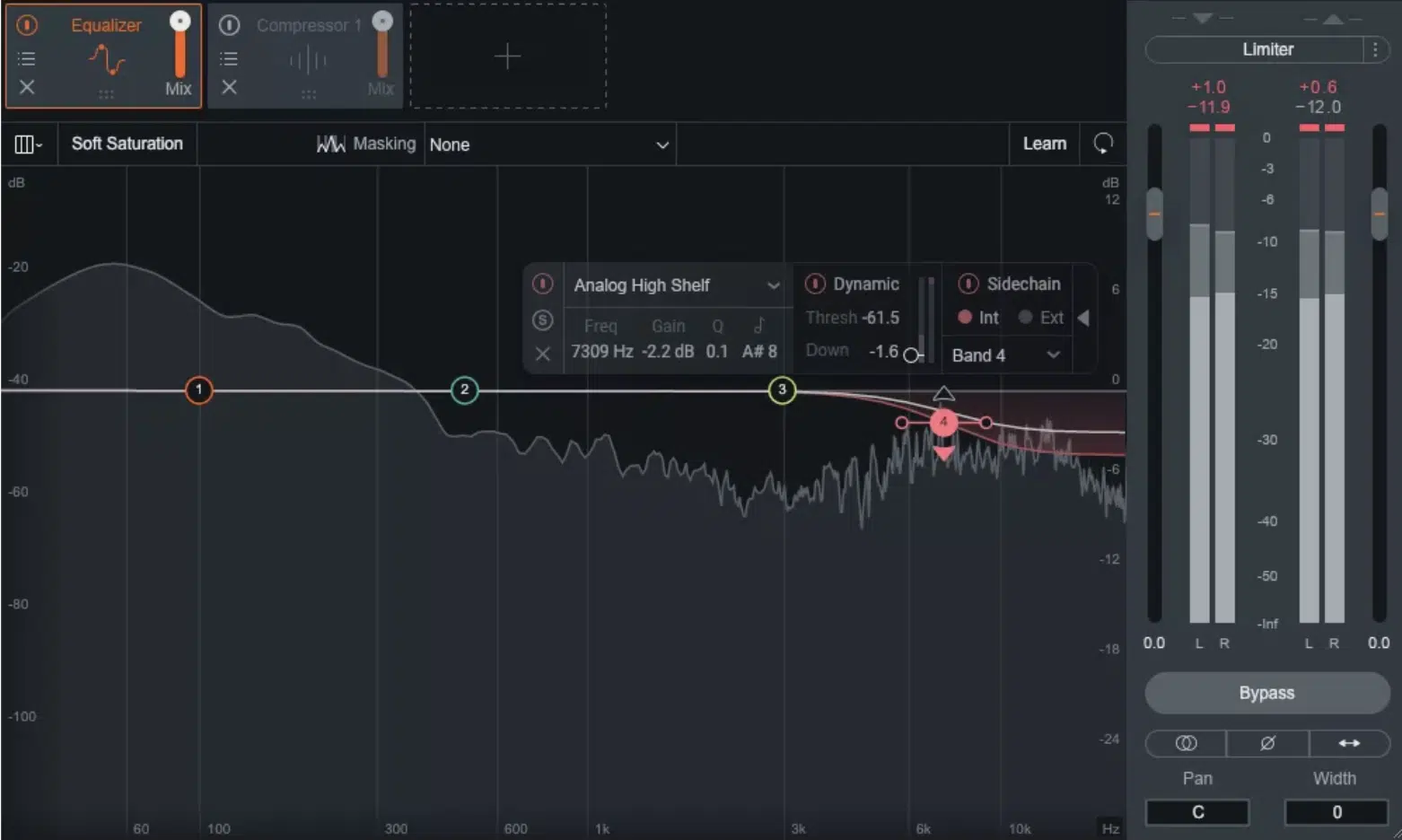
Treble cutting techniques are just as important for taming high frequencies that may cause ear fatigue or create an unbalanced mix.
And yes, please believe me people, ear fatigue is a real thing.
Cutting the mid treble/mid frequencies around 8,000 Hz to 10,000 Hz can be effective in reducing sibilance and harshness in a singer’s voice, especially when recording a typical voice or a shrill voice that sits prominently in the treble range.
Using a low-pass filter or a dynamic EQ to cut unwanted high frequencies can help focus the audio quality without losing clarity in the mid-range frequencies.
NOTE: For a balanced mix, the goal is to reduce treble sounds that may be too sharp or dominant, ensuring a smooth integration with the bass frequencies and mid-range.
Common Tools/Plugins You’ll Use for Controlling Treble Frequencies
You’ll find various tools and plugins to help you control treble frequencies like a boss. They’ll provide flexibility in shaping the treble frequency range, helping you fine-tune the treble and bass to achieve the best sound quality possible (which you should always be shooting for).
-
Equalizer Plugins
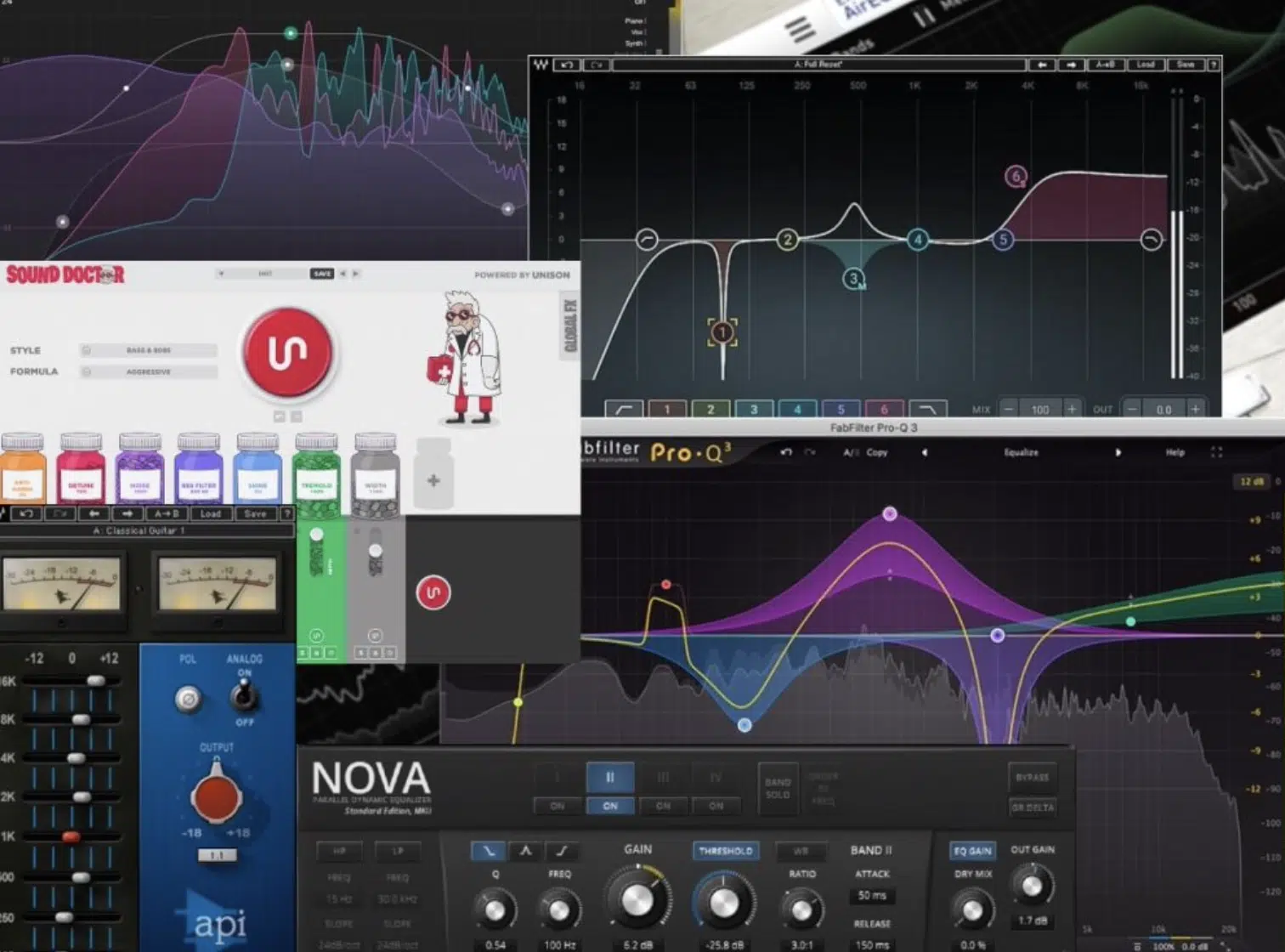
Equalizer plugins (like FabFilter Pro-Q 3 and Waves SSL G-Equalizer) are, of course, the most popular tools for managing treble frequencies in a mix.
They give you precision/control over the treble range to shape the upper treble and lower treble to enhance audio quality.
Using these plugins, boosting the treble around 10,000 Hz can bring out the presence of musical instruments, while cutting around 6,000 Hz can tame high-pitched sounds that might otherwise dominate the mix.
They’re essential for ensuring that treble and bass frequencies are balanced across various frequency ranges.
-
Exciters and Enhancers
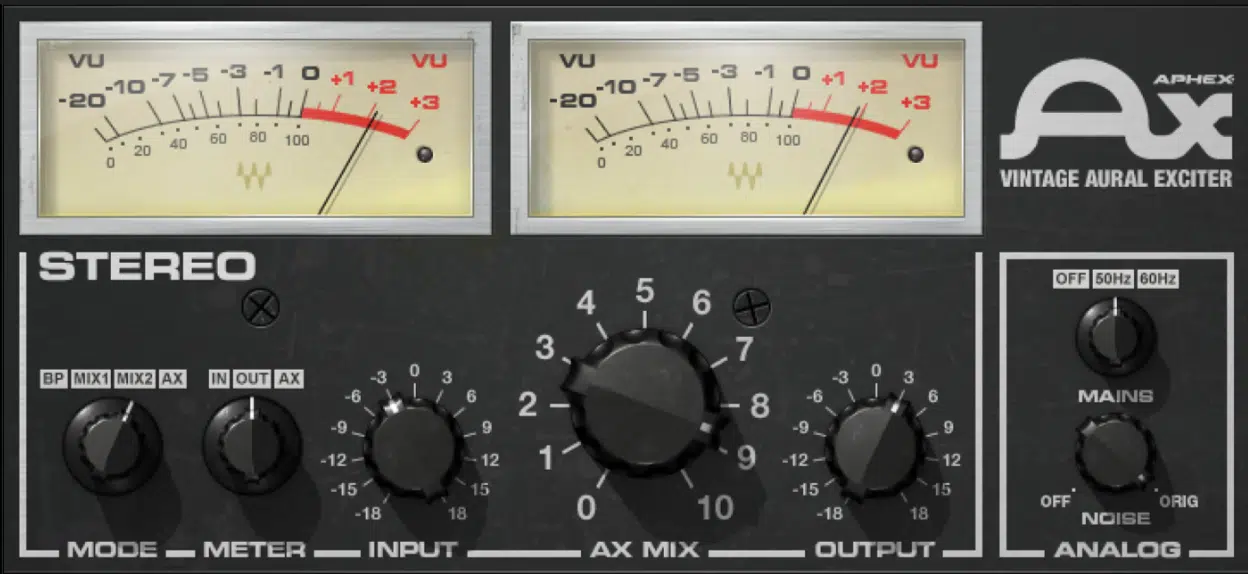
Exciters and enhancers are specialized plugins that add harmonic content to treble frequencies, giving a mix a brighter and more polished sound.
For example, the Aphex Vintage Aural Exciter can add subtle brightness to the upper treble, making your elements like vocal treble notes and bass guitars more vibrant.
These tools are super useful for enhancing the clarity of a mix without making the sound too harsh or unnatural.
NOTE: They work well alongside equalizer plugins to boost treble frequencies in a controlled manner, enhancing the overall audio frequency spectrum.
-
De-Essers and Dynamic EQs
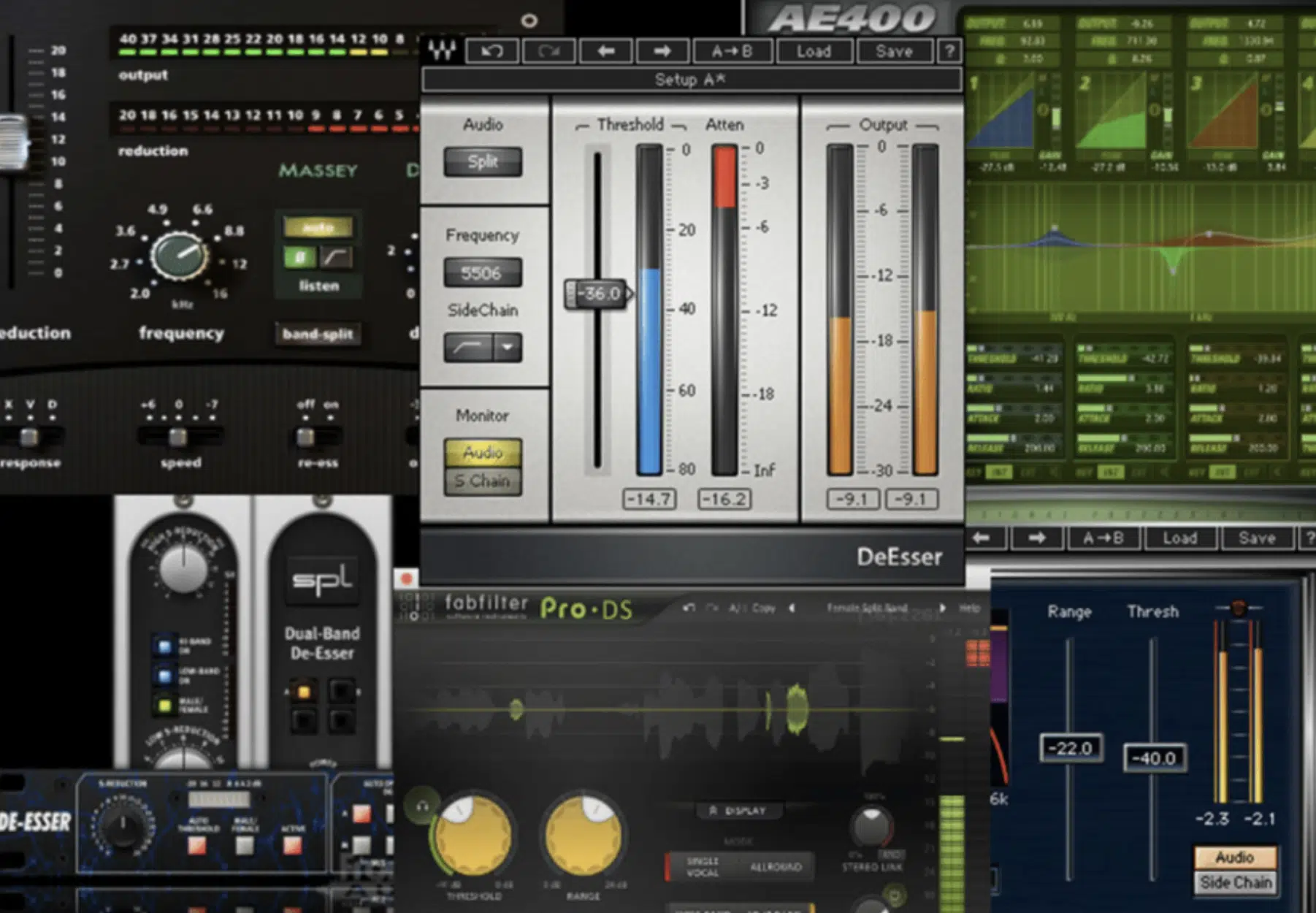
De-Essers and dynamic EQs are invaluable when it comes to managing many sounds that are harsh caused by excessive treble frequencies, especially in vocals.
Waves Sibilance and FabFilter Pro-DS are my personal favs.
They specifically target sibilance in the treble frequency range around 6,000 Hz to 10,000 Hz, softening the sharpness of high-pitched sounds.
And yes, I’m repeating the ranges a lot so you can get it drilled into your heads.
Dynamic EQs, on the other hand, provide a more flexible approach 一 allowing you to reduce treble frequencies dynamically based on the incoming audio signal.
This control helps maintain a balanced mix, where treble sounds do not kill the bass notes or mid-range frequencies.
Advanced Tips for Treble Control
If you’re looking to take your treble control to the next level, the following advanced tips/techniques can certainly help. They’ll help you focus on achieving a balanced and polished sound across all frequency ranges in a mix.
-
Using Saturation to Tame Treble
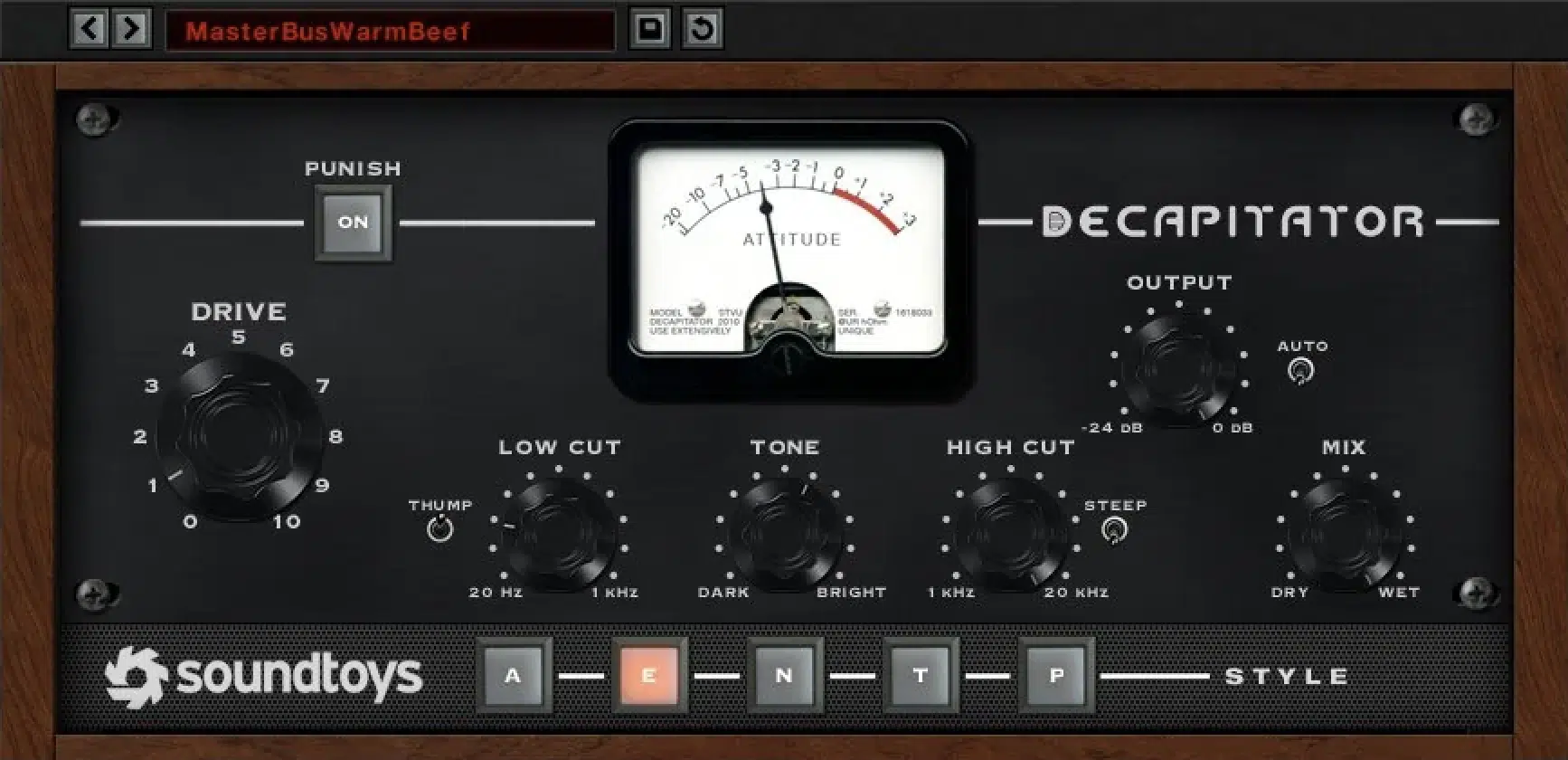
Saturation is another powerful tool for taming harsh treble frequencies while adding warmth and character to a mix.
When applying saturation to the upper treble (12,000 Hz to 20,000 Hz), it can help soften high sounds like cymbals or the bright sound of a singer’s voice without dulling the mix.
For example, plugins like Soundtoys Decapitator or FabFilter Saturn can introduce subtle harmonic distortion that smooths out the treble frequency range.
This way your higher frequencies won’t overpower the bass sounds.
Saturation can also help balance treble and bass by making the bass frequencies sound fuller and more rounded 一 enhancing the overall sound quality.
-
Stereo Imaging and Treble
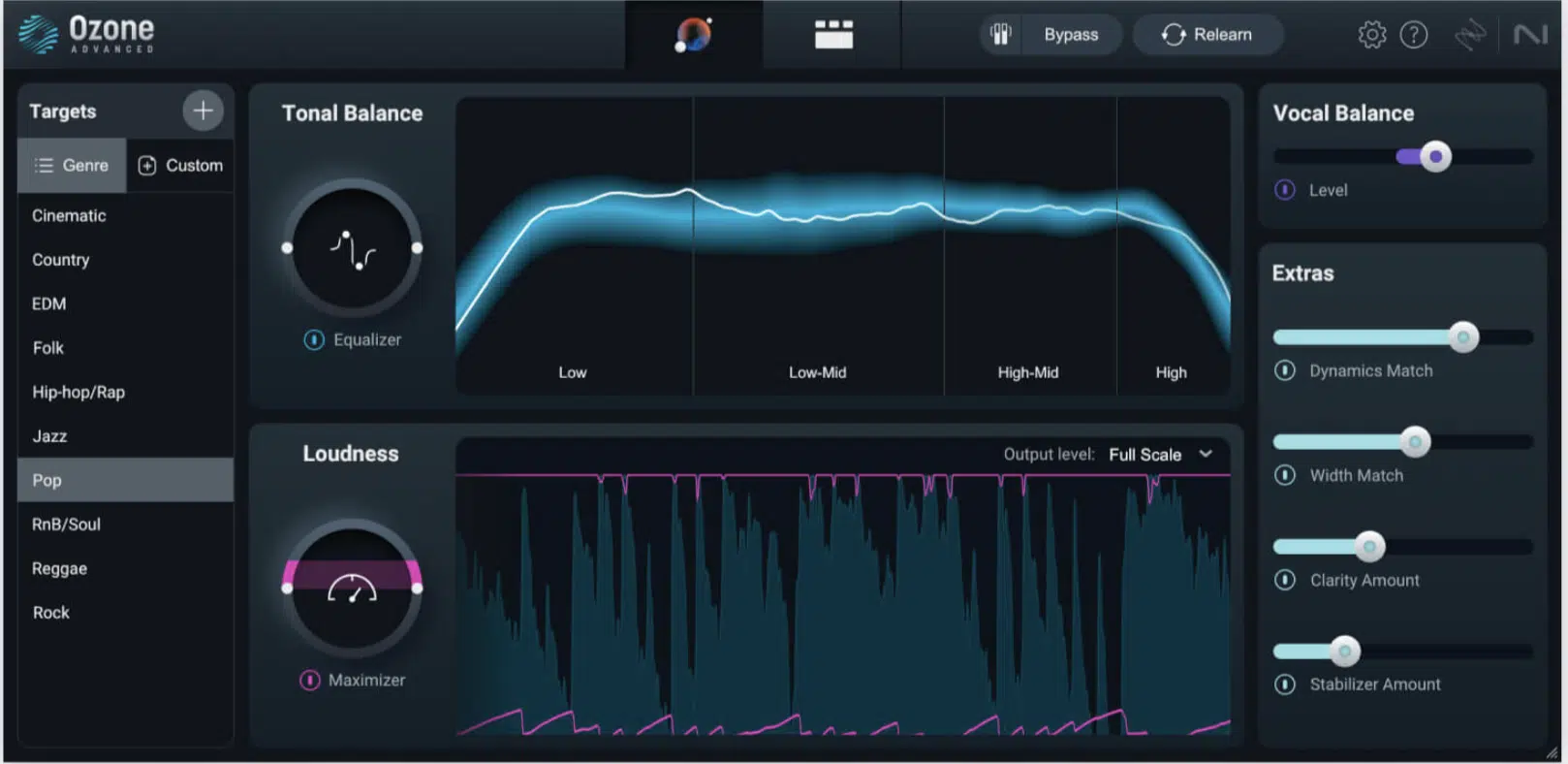
Stereo imaging is a great technique for enhancing the presence and width of treble sounds in a mix, especially when dealing with high frequencies.
Widening the stereo image of upper treble frequencies (between 14,000 Hz and 18,000 Hz) can add depth and spaciousness.
It will make treble notes like those from rhythm guitars or treble strings/bass strings more prominent.
Try out different plugins like iZotope Ozone Imager; with them, you can control the stereo width of treble frequencies without affecting the low frequencies.
NOTE: Be cautious not to widen the treble range excessively, as it can lead to phase issues or a disconnected mix where treble and bass frequencies do not blend smoothly.
A balanced stereo image helps in creating a full, immersive audio experience that maintains clarity and detail.
-
Automation for Dynamic Treble Control
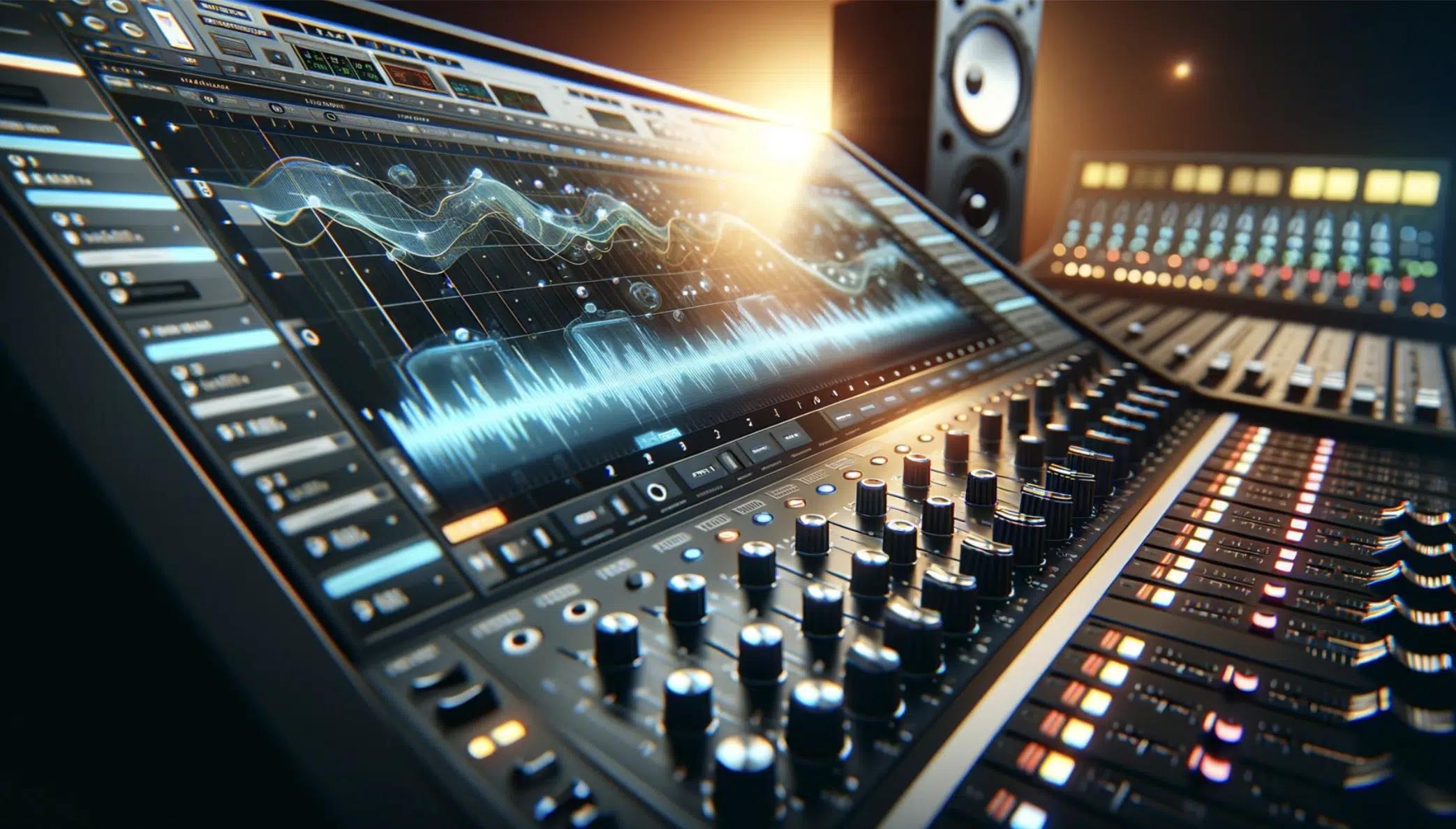
Automation offers dynamic control over treble frequencies throughout a track so you can tweak the treble frequency range to fit your specific musical context.
For example, automating a slight boost in the upper treble (15,000 Hz to 20,000 Hz) during choruses can make a mix sound brighter and more energetic.
On the other hand, reducing the treble range in verses can create a more intimate, close sound.
This technique can be super useful in balancing treble and bass frequencies dynamically 一 ensuring that the bass guitar and kick drum remain punchy.
By mastering automation, you can knock out mixes where treble sounds are always balanced, clear, and impactful across the audio frequency spectrum.
What is Treble: Final Thoughts
Now that you know what treble is and how it shapes the sound quality of a mix, you can use this knowledge to make killer mixes and produce better.
You’ve learned how to manage the treble frequency range to add brightness and clarity or reduce harshness that can fatigue the human ear, so you got this.
By balancing treble and bass frequencies, you can ensure that every element in your mix (whether it’s a kick drum or a singer’s voice) sits perfectly in the frequency spectrum.
Bottom line, understanding “what is treble” allows you to create mixes that are both polished and professional, with clear and distinct treble sounds that enhance your tracks.
To refine your mixes even more, you’ve got to check out this invaluable House & Deep House MIDI Melody Collection.
It’s packed with 120 drag-and-drop MIDI melodies that are perfect for producers looking to add brightness and melodic complexity to their tracks.
Whether you’re using leads to create a driving force or arpeggios to brighten up the upper treble, these melodies help you achieve a balanced, high-quality sound.
With the flexibility to edit, transpose, and customize these melodies, you can easily integrate them into your projects and elevate your music production.
So, by understanding “what is treble” and mastering its control, you can enhance your sound quality and prevent harshness.
Plus ensure every element in your mix is heard distinctly.
With the right knowledge and tools, you’ll be able to shape treble frequencies like a professional, ensuring your tracks captivate listeners and stand out in any genre.
Until next time…







Leave a Reply
You must belogged in to post a comment.